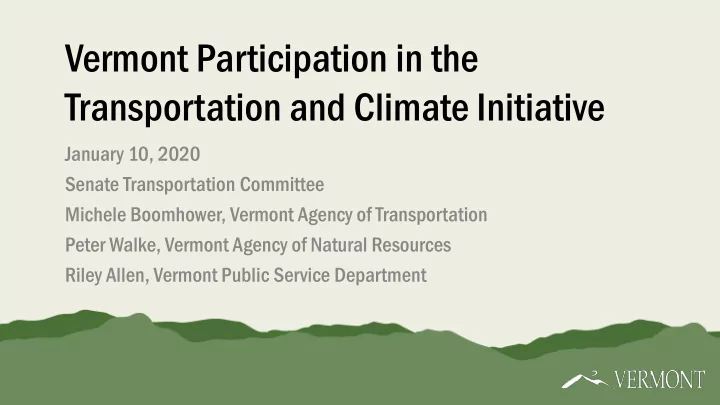

Vermont Participation in the Transportation and Climate Initiative January 10, 2020 Senate Transportation Committee Michele Boomhower, Vermont Agency of Transportation Peter Walke, Vermont Agency of Natural Resources Riley Allen, Vermont Public Service Department
Why Focus on Transportation Emissions?
TCI Overview • The Transportation and Climate Initiative (TCI) launched in 2010 as a collaboration amongst Northeastern and Mid-Atlantic states about how to reduce transportation GHG emissions • In December 2018, 9 of the 12 states (plus D.C.) announced that we would spend the next year developing a cap-and-invest policy proposal • In December 2019, the region put out a draft MOU and modeling results. We are asking for public input on that information • This is the first step in the process; state will decide individually whether to participate
History of Pollution Reduction Programs “Command -and- Control” - This is the traditional regulatory model that dictates the • outcomes (based on legislative frameworks) each facility must achieve – These programs guarantee pollution reduction, but those reductions may come at higher cost • “Cap -and- Trade” – By setting a shared rather outcome rather than individual ones and creating a market for pollution “allowances,” these types of program reach the overall shared outcome at the minimum cost for all facilities – This program seeks the same pollution reductions but accounts for the fact that different facilities that meeting program outcomes come at different costs to different facilities – Works best on programs where supply side reductions are cost-effective – Examples: Leaded gasoline phasedown and the Acid Rain Program
History of Pollution Reduction Strategies • “Cap -and- Invest” – Instead of being issued allowances, facilities have to purchase allowances in an auction (or continue to buy them from each other) – The auction proceeds are used to reduce consumer demand – The auction market finds the most cost-effective balance between the effect of the cap to clean up the supply and effect of reinvestment programs to reduce consumer demand
“Cap -and- Invest” – VT’s RGGI experience • Nine Northeast and Mid-Atlantic states launched RGGI in 2009 • Major power plants are required to buy allowances at auctions or from each other • States invest revenue into efficiency and other initiatives that drive down consumer demand • Net result: More than 40% reduction in emissions at lowest cost • New Jersey, Virginia, and now Pennsylvania planning to join RGGI
Draft TCI MOU In December, the TCI region issued a draft MOU Some of the key elements include: • The program’s focus on equity • Affected fuels (Gasoline and on-road diesel) • Regulated entities – primarily position holders at the terminal rack • Monitoring and verification requirements • Market Characteristics • The need for complementary policies
TCI Modeling Results As part of the release of the Draft MOU, the region conducted and released economic, transportation, and public health modeling. Key points: • The region is seeking feedback on three cap scenarios: 20, 22, and 25% reductions over a 10-year period • There will likely be a direct impact on the coast of fuel • The program will create significant proceeds to develop in programs to help Vermonters • Overall economic impact is modestly positive • Significant public health benefits
TCI Policy Proposal Next Steps (Regional) Current Stage Release draft Gather public Release Gather and States seek October 2019 Oct-Nov 2019 December 2019 Spring 2020 Fall 2020 regional policy input regional policy consider public input on a proposal as input on model rule to proposal on framework framework draft Draft MOU and implement Memorandum release final regional of program MOU. Understanding (MOU) 2022 Program implementation begins
Legislative Participation in RGGI • Under RGGI, the Governor signed the MOU, then the General Assembly passed enabling legislation • ANR developed rules in conjunction with the other states in the region to put the program into place • The General Assembly dictated how the proceeds would be spent – sent through PUC primarily for weatherization
Questions?
Recommend
More recommend